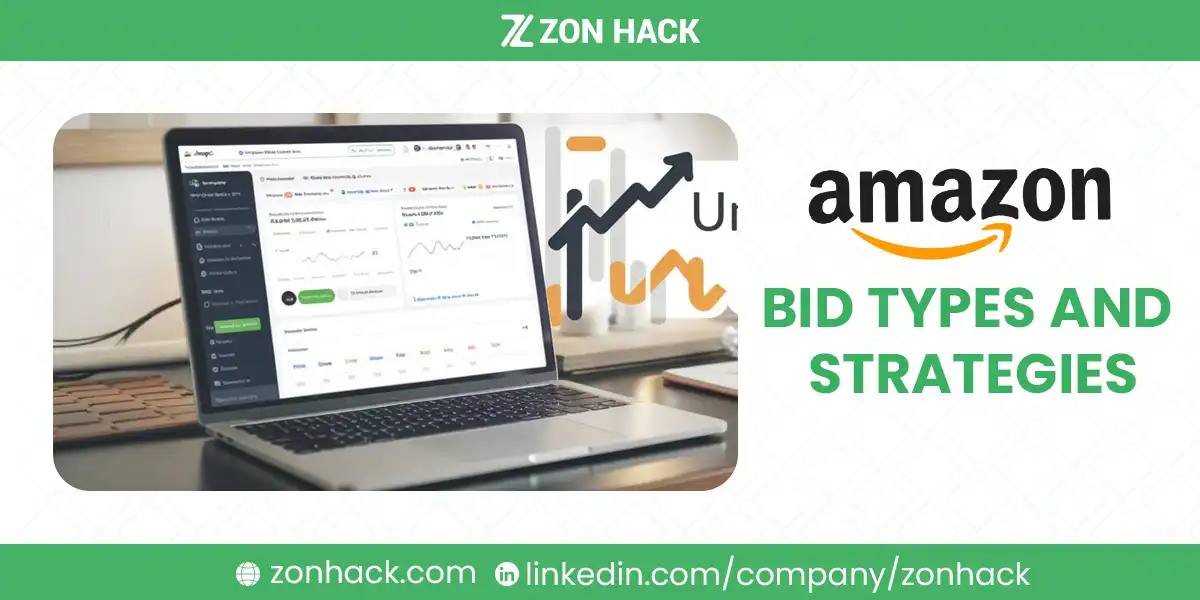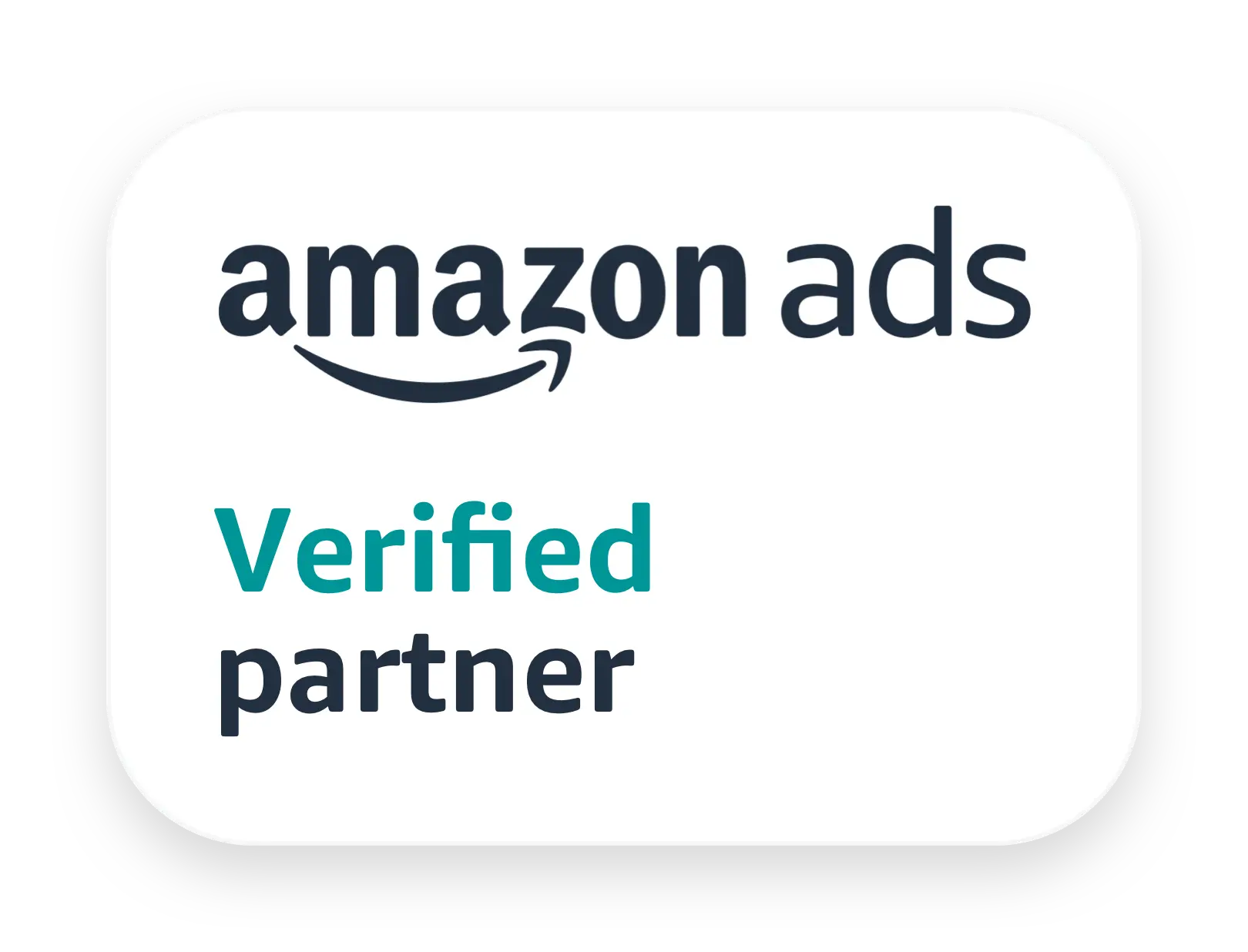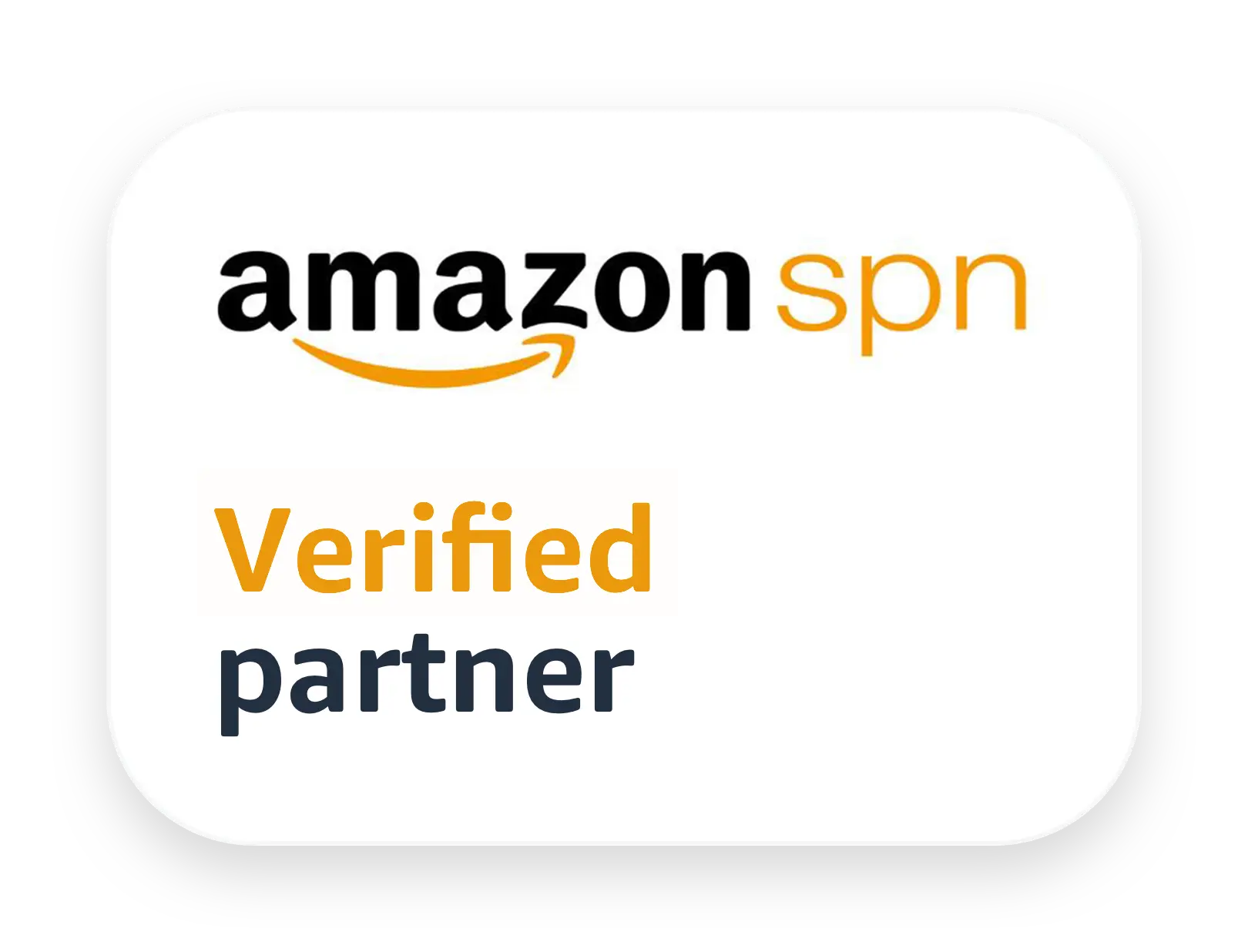There’s a reason sellers lose money on Amazon ads—and it’s not always because they bid too high.
Often, they bid without a strategy.
If you’re selling on Amazon, you already know this is a pay-to-play platform. Every Sponsored Product ad, every headline you see, every carousel on a product detail page—it’s all backed by a bid.
But here’s what most don’t realize:
Winning isn’t just about bidding more. It’s about bidding smart.
At ZonHack, we’ve managed PPC campaigns across hundreds of ASINs, from product launches to 7-figure catalogs. The patterns are clear:
- Sellers without a structured bid strategy tend to overspend fast.
- Others go too cautious and lose visibility, costing sales just the same.
Whether you’re trying to break into the Top of Search or squeeze efficiency from a retargeting campaign, your bidding strategy determines how visible—and profitable—you’ll be.
This guide breaks it down. No jargon. No fluff. Just a clear blueprint on how to choose the right bid types, optimize them over time, and scale profitably.
Inside the Amazon Ad Auction: The Second Price Model
Amazon doesn’t run your typical auction.
Instead, it uses a Second Price Auction model. Here’s how that works:
Let’s say you bid $1.20 for a keyword.
The next highest competitor bids $1.10.
You win the placement—but you don’t pay $1.20. You only pay $1.11. Just $0.01 more than the second-highest bid.
Why does this matter?
Because it means you don’t need to max out your bid to win. You just need to outbid your competition—strategically.
This is exactly why understanding how your bids interact with Amazon’s logic is so important. A smart bid structure can win top placements at lower costs, as long as you know how to play the system.
Core Amazon Bidding Strategies (in Seller Central)
Amazon offers three core bidding strategies at the campaign level for Sponsored Product Ads (SPA). These settings influence how your bids are adjusted during auctions—and they determine how aggressive or conservative your ad delivery becomes.
Let’s look at each one in simple terms:
A. Dynamic Bids – Down Only
This is the most conservative option.
When Amazon thinks a click is less likely to convert into a sale, it will lower your bid automatically.
But here’s the catch: It will never increase your bid—even if the conversion potential is high.
So, you’re essentially protecting your budget at the expense of potential high-converting traffic.
Best for:
- New campaigns
- Product launches
- Testing keywords with low historical data
ZonHack Tip:
This is our go-to for new SKUs or testing phases. It gives us clean data without setting fire to the ad budget. Once we see what’s converting, we scale.
B. Dynamic Bids – Up and Down
This one gives Amazon more control.
Your bids will go down when conversion likelihood is low, and up when Amazon believes the shopper is likely to buy.
How much up?
- Up to +100% for Top of Search
- Up to +50% for other placements
This strategy is great when you’ve proven product-market fit and want to push sales harder.
Best for:
- High-converting products
- Sales-focused campaigns
- Prime Day or BFCM pushes
When to switch:
After validating strong CTRs and conversion rates with “Down Only.” This strategy helps amplify momentum once you know what’s working.
C. Fixed Bids
Here, Amazon leaves your bid alone. No adjustments.
You get full control. But you lose any algorithmic advantage from Amazon optimizing placements based on conversion signals.
Use this when:
- You have a tight budget cap
- Running brand awareness or visibility-focused campaigns
- Retargeting known audiences
Why it works:
Fixed Bids are about precision, not flexibility. They give you predictable ad spend—a useful lever when controlling margins or focusing on impressions.
Adjusting Bids by Placement (The New “Bid+”)
Choosing a bidding strategy is only half the equation.
Amazon also lets you adjust how much you’re willing to pay based on where your ad appears.
There are three key placements:
- Top of Search (first page) – where shoppers convert the most
- Rest of Search – generally lower intent
- Product Pages – perfect for targeting competitors or cross-selling
Let’s break this down further.
A. How Placement Bidding Works
You can manually increase your base bid depending on where you want to appear.
Amazon allows:
- Up to +900% for Top of Search
- Up to +400% for Product Pages
Example:
Let’s say your base bid is $0.75.
If you apply a +500% modifier for Top of Search, your effective bid becomes:
$0.75 × (1 + 5.0) = $4.50
That’s how sellers win premium real estate on high-converting pages—by strategically multiplying their bid only when it matters most.
B. What Happens with Dynamic Bidding?
It’s important to understand that placement modifiers are not additive with dynamic bidding. They’re layered.
Here’s how the math plays out:
- Amazon applies your placement modifier
- Then, if your strategy is Dynamic Up and Down, it adds on another adjustment
Example:
- Base Bid: $0.75
- Top of Search +900% = $7.50
- Dynamic Up +100% = final bid of $15.00
ZonHack Strategy Insight:
When we manage rank acceleration campaigns, we often combine Top of Search modifiers with “Up and Down” bidding. It helps win key placements faster, especially for high-volume keywords with strong purchase intent.
Putting It All Together: Smart Bid Strategy by Scenario
Understanding bid types is one thing. Knowing how to use them in real-world scenarios is where the real advantage comes in.
Let’s break down some of the most common campaign types Amazon sellers run—and the smartest bidding approach for each.
Scenario 1: Product Launch
Recommended Strategy: Dynamic Bids – Down Only
When launching a new product, you want visibility, but you also need to avoid wasted spend.
Most keywords won’t convert right away. With “Down Only,” Amazon reduces your bid when there’s a low chance of conversion. That helps collect valuable data at a lower cost.
ZonHack Tip: Run “Down Only” campaigns for 7–10 days post-launch. Monitor CTR and conversion rate. Then decide whether to scale or pivot.
Scenario 2: High-Converting ASIN
Recommended Strategy: Dynamic Bids – Up and Down + Top of Search Placement Adjustment
When you have a product that’s already proven itself—strong reviews, high conversion, good CTR—this is the time to get aggressive.
By allowing Amazon to increase your bid (especially for Top of Search), you can outpace competitors and take control of premium real estate.
Combine that with a placement multiplier (e.g., +400–600% for Top of Search), and you can scale rapidly.
Example: One of our ZonHack clients selling fitness gear used this combo to triple daily sales while maintaining a 22% ACoS during Q4.
Scenario 3: Retargeting Campaign
Recommended Strategy: Fixed Bids + Product Pages Placement Adjustment
Retargeting ads aren’t about discovery—they’re about bringing shoppers back.
With a Fixed Bid strategy, you control exactly how much you’re willing to spend. Combine this with a +100% to +300% adjustment on Product Pages, where customers may see your product while browsing competitors.
This setup is also useful for cross-selling related products from your brand.
ZonHack Tip: For DTC brands selling via Amazon, retargeting with fixed bids often yields the lowest ACoS across all campaign types.
Scenario 4: Brand Defense
Recommended Strategy: Dynamic Bids – Down Only
Defending your brand terms is crucial. You don’t want competitors running ads on your own listings and stealing sales.
But here’s the key: You also don’t want to overpay for clicks you would likely get organically.
“Down Only” allows you to stay visible without inflating CPCs.
Real-World Example: A ZonHack fashion seller saved 38% in monthly ad spend by switching brand term campaigns from Fixed to Down Only—without losing visibility.
Scenario 5: Ranking Push for Competitive Keywords
Recommended Strategy: Dynamic Bids – Up and Down + Top of Search Placement + 900% Adjustment
When trying to rank for competitive, high-value keywords, you have to go bold.
This strategy can make your bid up to 10x higher for top placements, but only when conversion likelihood is high. That’s how you force visibility during ranking campaigns without wasting every penny.
Use this method for short-term bursts—3 to 7 days—to maximize keyword traction and organic lift.
ZonHack Framework: We pair this bidding style with aggressive keyword tracking tools and conversion heatmaps. If there’s no movement within a week, we reassess and reallocate spend.
Monitoring, Adjusting, and Scaling Your Bids Over Time
Even the best bid strategy needs adjustment.
Amazon’s auction is dynamic, and your CPCs, CTRs, and ACoS will shift over time. Here’s how to stay ahead:
1. Watch Key Metrics Weekly
- Impressions: If they’re dropping, your bids might be too low.
- CTR (Click-Through Rate): Below 0.3% usually signals poor ad placement or irrelevant targeting.
- Conversion Rate: Anything under 10% should be investigated.
Set a weekly review cadence to spot trends—not just snapshots.
2. Adjust Bids Based on Performance
Don’t raise or lower bids just because the ACoS looks high.
Instead, dig deeper:
- Is a high ACoS coming from low conversion or high CPCs?
- Could a placement modifier fix it?
- Is the keyword even worth bidding on?
ZonHack Tip: In accounts spending over $10K/month, we often apply bid automation rules. But those rules are always layered with human oversight and weekly audits.
3. Use Dayparting (Time-Based Bidding) if Applicable
Some niches convert better at certain hours or days. Use Amazon’s reports or external tools to identify those trends.
If you notice peak sales between 7–10 PM, consider boosting bids during that window only.
Dayparting isn’t available natively in Amazon Ads, but with tools like ZonHack’s custom PPC scripts or third-party bid managers, it becomes a powerful layer of optimization.
4. Scale What Works—Cut What Doesn’t
Scaling isn’t just about raising budgets.
It’s about consolidating winning bids, identifying strong keywords, and removing waste.
Even for large brands, 30–40% of spend often goes toward underperforming search terms. Audit weekly. Reallocate monthly.
Bottom Line: Don’t Let Your Bids Run Blind
Amazon Ads isn’t a set-and-forget system. Bidding isn’t just about showing up—it’s about showing up profitably.
Here’s the reality:
- A higher bid doesn’t always win—it just raises your costs.
- Smart bidding is about intent, placement, timing, and control.
At ZonHack, we don’t chase every click. We build scalable PPC systems tailored to each product lifecycle—whether you’re launching, scaling, or defending.
With the right structure, the right modifiers, and a clear goal, Amazon’s auction becomes a tool—not a gamble.
Want smarter bids without babysitting your campaigns?
ZonHack’s PPC specialists can set up, manage, and optimize your bids with performance-first logic—backed by real data, not guesswork.
FAQs: Amazon PPC Bidding Strategies
What is the best bidding strategy for new Amazon products?
Start with Dynamic Bids – Down Only. It lowers bids when conversion is unlikely, reducing risk while collecting keyword performance data.
How often should I adjust my bids?
Review weekly, especially for high-spend campaigns. Bid adjustments should be based on keyword performance, not just overall ACoS.
Can I use different bidding strategies in the same account?
Yes. Use different strategies per campaign, tailored to product goals. For example, “Up and Down” for best-sellers, and “Fixed Bids” for retargeting.
What’s the ideal Top of Search bid adjustment?
There’s no one-size-fits-all. Start low (+100% to +300%) and scale based on conversion rates. High performers may justify a +900% multiplier during ranking pushes.
Do I need software to manage my Amazon bids?
Not always. For smaller sellers, manual optimization works. But if you’re spending $5K+/month, tools or managed services (like ZonHack) save time and improve efficiency.




